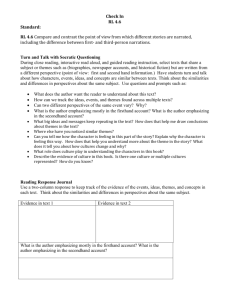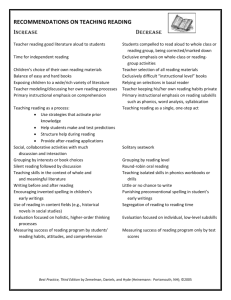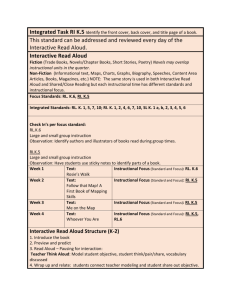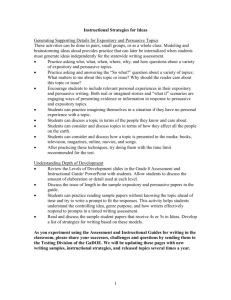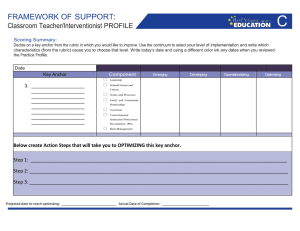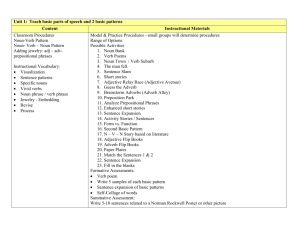Check In RI 4.7
advertisement
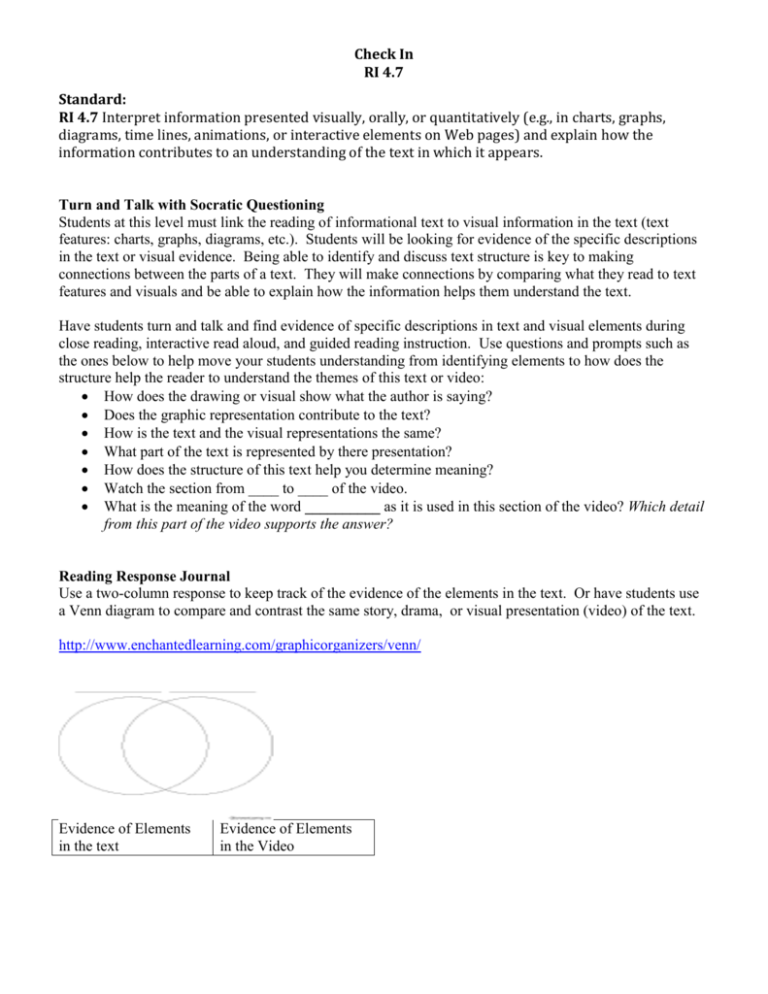
Check In RI 4.7 Standard: RI 4.7 Interpret information presented visually, orally, or quantitatively (e.g., in charts, graphs, diagrams, time lines, animations, or interactive elements on Web pages) and explain how the information contributes to an understanding of the text in which it appears. Turn and Talk with Socratic Questioning Students at this level must link the reading of informational text to visual information in the text (text features: charts, graphs, diagrams, etc.). Students will be looking for evidence of the specific descriptions in the text or visual evidence. Being able to identify and discuss text structure is key to making connections between the parts of a text. They will make connections by comparing what they read to text features and visuals and be able to explain how the information helps them understand the text. Have students turn and talk and find evidence of specific descriptions in text and visual elements during close reading, interactive read aloud, and guided reading instruction. Use questions and prompts such as the ones below to help move your students understanding from identifying elements to how does the structure help the reader to understand the themes of this text or video: How does the drawing or visual show what the author is saying? Does the graphic representation contribute to the text? How is the text and the visual representations the same? What part of the text is represented by there presentation? How does the structure of this text help you determine meaning? Watch the section from ____ to ____ of the video. What is the meaning of the word __________ as it is used in this section of the video? Which detail from this part of the video supports the answer? Reading Response Journal Use a two-column response to keep track of the evidence of the elements in the text. Or have students use a Venn diagram to compare and contrast the same story, drama, or visual presentation (video) of the text. http://www.enchantedlearning.com/graphicorganizers/venn/ Evidence of Elements in the text Evidence of Elements in the Video Check In RI 4.7 Close Reading Structure Lens Lesson Plan Example: Week 4 Transcontinental Railroad Video – Westward Expansion http://www.history.com/topics/westward-expansion Students will also need access to close reading passages from weeks 1-3. Instructional Focus (Standard and Focus): RI 4.4, L4.4a-c Academic Vocabulary in context. Use reference material to confirm word meaning. Introduce Text Vocabulary Development Identify Genre: Text Structure: Read Aloud and scaffold vocabulary. (Intentionally plan this lesson based on the Language Standards and Vocabulary, student needs and the text you’ve selected.) Vocabulary in the video: Instructional Focus (Standard and Focus): RI 4.1, SL 4.2 Referring to details and examples in text, paraphrase portions of text read aloud or media sources. Close Reading 1. Read through a lens. Replay the video looking for Role of Transcontinent al Railroad in Growth of the West. Have students highlight text evidence. Chart student responses in the first column of Instructional Focus (Standard and Focus): RI 4.7 Interpreting Information Close Reading 2.Look For Patterns 3.Developing a new understanding Replay video Look for Patterns In small groups reread the passage and the evidence from yesterday. Have students work in pairs and find which pieces of evidence fit together. Chart the patterns you find in the second column of your anchor chart. Instructional Focus (Standard and Focus): W4.1 RI 4.7 Opinion Writing How does the information contribute to the understanding of the text Assessment Narrative or Expository Writing Task Teacher will pose an open-ended question for students to respond to in written form. This may be an opportunity to encourage students to respond using technology. Students will work on this task independently, using Instructional Focus (Standard and Focus): W4.8, W4.9 Gathering relevant information in the text. Explain how authors use reasons to support text. Assessment Narrative or Expository Writing Task Model how to use the PARCC Literary Response Rubric so students can assess their writing with a partner. Model identifying 1 or 2 areas that students could improve in their response based on the rubric. Have students get Check In RI 4.7 Make a list Replay video looking for clues for meaning of words. KIM See reference below. Ke Inf Me y or mo wo ma ry rd tio Clu n e Confirm meaning using reference materials. an anchor chart. Developing a new understanding Review anchor chart evidence and patterns. Turn and Talk about noticing’s. Oral Synthesis in small groups: Statement using sentence frame: – First I was thinking ______ now I am thinking _____ because…. Share out students Synthesis with whole group. evidence from the text. Open Ended Question: Compare the video and 1 of your close reading texts from this unit. Provide examples of how the geography affected the growth of the west. in groups of four and share their Open Ended Responses to the prompt. Students will provide 1-2 things the writer could do to improve their response. Students should spend 10 minutes revising their responses to the open ended question based on the feedback they received. Share 2-3 revised responses with the whole class.
